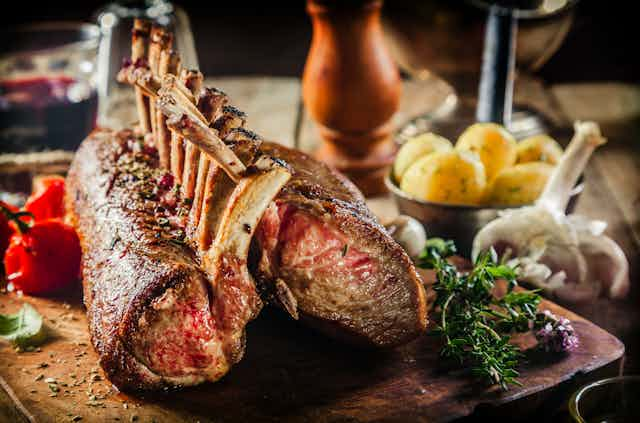For those who enjoy a meaty spread during the festive season, it’s worth knowing that not all lamb tastes the same. It depends on where it comes from, and what it has been eating.
South African folklore has long suggested that sheep meat in the country has a distinct – often herbal or even medicinal – flavour and aroma. But more recently, studies have confirmed that there is a detectable sensory difference in sheep meat produced in different regions of southern Africa.
The flavour of meat develops through cooking. Flavour can also be added to meat through brining or marinating. But the inherent flavour in meat is largely dependent on what the animal feeds on.
Traditionally it has been believed that high-energy, grain-based diets produce more intense flavours in red meats than forage or grass diets. But the fact that the pungent flavour and aroma of local lamb and mutton comes from sheep reared on natural pastures and open fields goes against this.
Lamb and mutton from certain grazing regions such as the Karoo or Free State have their own unique flavours. These meats are often sought after by South African consumers who prefer a certain taste and are prepared to pay a premium for it.
Establishing an unique taste
Sheep are produced in most corners of South Africa. Special breeds do well in arid areas. They can withstand harsh temperatures, arid soils and sparse vegetation in areas where there is limited rainfall. The Karoo in South Africa’s Northern Cape province is one such area.
The Karoo Development Foundation was established in 2009 to certify meat from the region. The certification scheme would mean lamb and mutton products from the area could be traded using the Karoo Meat of Origin certification.
A study was done to evaluate the aroma, texture and flavour attributes of sheep meat from different regions in South Africa. The aim was to determine whether, statistically, there was a significant difference in the taste of meat from sheep reared in different parts of South Africa, stretching into Namibia.
During the study, mutton carcasses from two major breeds of sheep – Dorper and Merino – were procured from eight farms in various regions. These include the Free State, Kalahari, Northern Cape (specifically De Aar and Carnarvon), and Namibia.
The study found that mutton from the Karoo region – in the Northern Cape and Kalahari – had definite flavour characteristics. These could be attributed to the grazing plants the sheep fed on.
Lamb and sheep from Karoo graze on indigenous plants found exclusively in this region. These plants can endure heat, cold, wind and hail, providing feed for the animals all year round. Karoo plants have developed in different ways to survive the harsh conditions of the region.
Sheep reared in the Free State have a different diet. This is a summer-rainfall region that gets very cold during the winter months, especially towards the eastern mountainous regions. The landscape features spacious grass-covered prairie land. These grasslands contribute to the associations of mild grass-like flavour attributes in meat produced in this region.
The flavour is in the fat
There are two other factors that play a role in the flavour of the meat: the fat and the age of the animal.
Fat is an energy source stored in animal muscles, which also contributes to the flavour of meat. Although water is the most prevalent component of meat, most of the aroma molecules which carry flavour are repelled by water but dissolve in fat.
Each animal has a unique fat content. This varies from cut to cut. Muscles that are used most by the animal contain the least amounts of fat. More tender cuts of meat which contain muscles that are less used by the animal will contain more fat and, as a result, more intense flavours.
Age also plays an important role in flavour development. The older the animal gets, the more time it has had to build up fat. As a result of age, more flavour is deposited within the meat.

